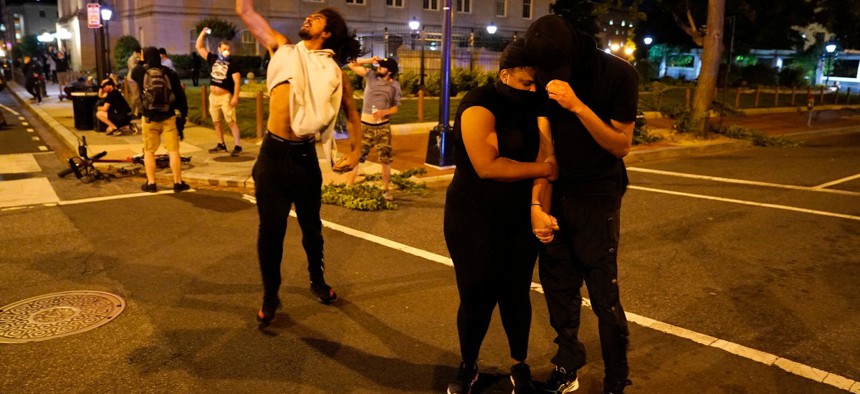
A helicopter circles low as demonstrators gather near the White House on June 1 to protest the death of George Floyd. Floyd died after being restrained by Minneapolis police officers. Evan Vucci / AP
Pentagon Says Guard Did Not Tear-Gas Protesters; Downplays Role In Militarized Response
A senior official also said the secretary of Defense was unaware of the plan to clear a public park for a Trump photo op.
National Guard troops who helped forcibly clear peaceful protesters from a Washington, D.C., square near the White House on Monday night were not equipped with tear gas or rubber bullets, a senior defense official said Tuesday, tacitly deflecting blame for the widely condemned assault onto law enforcement.
“The National Guard forces do not have tear gas, do not have rubber bullets, so they did not do any of the firing,” the official said. (The U.S. Park Police has also denied firing the tear gas on protesters.)
Two senior defense officials who called a press conference on Tuesday morning sought to downplay the Pentagon’s extraordinary role in the response to the roiling protests in the nation’s capital. One of the two officials, both of whom insisted on anonymity, said that Defense Secretary Mark Esper and Joint Chiefs Chairman Gen. Mark Milley “were not aware” that President Donald Trump had ordered the clearing of Lafayette Square — in anticipation of an imminent photo op at a nearby church — and left the White House with the president to “view troops who were outside.”
"Once they began that walk off the White House grounds with the president, they continued with him” to the church, the official said.
The presence at the photo shoot of Milley in particular — in battle dress — has drawn fierce criticism from former military officers and other senior national security leaders who called the display a dangerous politicization of the military on domestic soil.
The official also said he did not know who had authorized the deployment of the military helicopters that hovered over downtown D.C. on Monday night, snapping tree branches and buffeting protesters with rotor wash. Reporters asked whether the use of helicopters, which some on the scene described as an effort to intimidate protesters, had been appropriate.
"I will get in touch with the D.C. Guard and get back to you with an answer,” the official said.
Finally, the official defended Esper’s assertion that government officials needed to “dominate the battlespace,” a startling reference to American streets, filled with a confusing combination of peaceful protesters, press, police, and some looters and other more violent demonstrators. Esper, the official claimed, was using a military term of art for the environment in which troops are operating, and cautioned reporters not to “read into” the language.
“I think all of you are very well aware that the DoD often communicates in a parlance unique to the profession of arms,” the official said. “You have a SecDef in uniform for more than 20 years. He was using the terms that we have.”
Both officials declined to speak on the record, even as outrage over Esper’s remarks has continued to boil through Washington and the national security community.
“This is bullshit. A ‘battlespace’ is where America fights its foreign enemies. We are talking here about US cities and fellow citizens,” tweeted Chris Brose, a former top aide to Senate Armed Services Committee Chairman John McCain, R-Ariz. “We need to leave the rhetoric of war out of domestic law enforcement.”
Meanwhile, there are now more than 100,000 National Guard forces activated to help respond to the protests, the officials said — more than twice the number activated to support COVID-19 response efforts — and active duty troops are being staged on the outskirts of Washington in case Trump invokes the 1807 Insurrection Act. Active duty Military Police troops from Fort Bragg and Fort Drum, as well as a battalion from the 82nd Airborne, have been ordered to stand by in the D.C. area, according to Fox News and others.
The president does not have the legal authority to deploy active duty troops to conduct law enforcement without invoking the Insurrection Act — which he threatened to do but did not on Monday — and state governors quickly fired back on his announcement that he had ordered “thousands and thousands of heavily armed soldiers, military personnel, and law enforcement officers” to quell civil unrest in Washington, D.C.
“I am your president of law and order and an ally of all peaceful protesters,” Trump said during brief remarks in the Rose Garden as police and National Guardsmen were clearing Lafayette Square for his upcoming photo op. “I have strongly recommended to every governor to deploy the National Guard in sufficient numbers that we dominate the streets.
“If a city or state refuses to take the actions that are necessary to defend the life and property of their residents, then I will deploy the United States military and quickly solve the problem for them.”
The Trump administration’s deeply militarized rhetoric and response to the crisis has deeply unnerved scholars of civil-military relations, many of whom note that the military is forbidden under the 1878 Posse Comitatus Act from practicing domestic law enforcement unless explicitly authorized by statute. If the president invokes the Insurrection Act, which stipulates that the president determine “as a result of a natural disaster [that] domestic violence has occurred to such an extent that the constituted authorities of the State or possession are incapable of maintaining public order,” he could use both federalized National Guard troops and regular military forces for law enforcement purposes. But critics say that further militarizing the government’s response will only inflame tensions and heighten policing disparities that spurred the unrest in the first place.
“I have serious concerns about using military forces to respond to protestors,” said House Armed Services Committee Chairman Adam Smith, D-Wash., in a statement. “The role of the U.S. military in domestic U.S. law enforcement is limited by law. It must not be used in violation of those limits and I see little evidence that President Trump understands this fundamental premise.”







